#lm 1935
Explore tagged Tumblr posts
Text

So people even cried over the 1935 movie, hmm?
61 notes
·
View notes
Text

LES MIS LETTERS IN ADAPTATION - Preface (Les Miserables 1935)
So long as there shall exist, by virtue of law and custom, decrees of damnation pronounced by society, artificially creating hells amid the civilization of earth, and adding the element of human fate to divine destiny; so long as the three great problems of the century—the degradation of man through pauperism, the corruption of woman through hunger, the crippling of children through lack of light—are unsolved; so long as social asphyxia is possible in any part of the world;—in other words, and with a still wider significance, so long as ignorance and poverty exist on earth, books of the nature of Les Misérables cannot fail to be of use. HAUTEVILLE HOUSE, 1862.
#Les Mis#Les Miserables#Les Mis Letters#Les Mis Letters in Adaptation#Victor Hugo#Les Mis 1935#Les Miserables 1935#WE'RE BACK BABY#I didn't start immediately last year so I'm going to do the chapters I missed last year.#And then take a break until we catch up to where I stopped making gifs.#Hopefully this will be easier on me and less stressful.#I am determined to finish this.#Anyway! LM 1935 bad!#pureanonedits#lesmisedit#lesmiserablesedit#lesmis1935edit#lesmiserables1935edit
232 notes
·
View notes
Text
Thank you!
The other illustrations, and the "Universal Library" imprint, confirm my theory: this is a movie tie-in to the 1935 Les Mis film, starring Frederic March and Charles Laughton as Javert, and Cedric Hardwicke as Bishop Myriel!
Here, you can see the artist really has a good handle on the actors' appearance, look:
Hardwicke's Myriel and March's Valjean, in the movie:

and in illustration:

Here's a shot of Frederick March as Valjean in his Madeleine days with Charles Laughton's Javert:

and the two of them in the illustration; you can see Laughton's very distinctive profile!:

The scene with the woman and child that first caught your eye is based on this moment, from Valjean's trial, when he's sentenced and taken away; that's his sister and one of her kids, not Fantine and Cosette:

This is obviously a movie tie-in, but printing photos must still have been cost -prohibitive, so they hired this illustrator. I really like that! It's neat seeing the illustrator reinterpret the movie scenes to an effective single composition.
..as for the movie's interpretation of the book, well, this is what the movie turns the preface into:

"so long as there exists in this world that we call civilized, a system whereby men and women, even after they have paid the penalty of the law and expiated their offenses in full, are hounded and persecuted wherever they go--this story will not have been told in vain."- preface to Les Miserables , according to the 1935 movie
Yeah! That's not at all what Hugo said, even though the movie attributes it to him. But the actors do a great job and so did this illustrator! Thank you for sharing this cool little find!




What?
Behold, an image from an old edition of Les Misérables has an illustration that is IDENTICAL to Benedict cumberbatch!!
Or is it just me?
#LM 1935#LM tie ins#this movie...the timeline gets SO WEIRD#Eponine's a secretary.#she has a heart to heart with JVJ about how they both hate M/C#as a ship#Valjean frees Javert and Javert just stands there having a loud tantrum . Absolute Crying Baby Javert#it's a trip#but at least it is easy to recognize!! XD
44 notes
·
View notes
Text
Freedom is Originality
What does freedom mean to you? The spirit of KALAGA “Freedom is Victory and Victory is Freedom. You just can’t have one without the other.” KALAGA LM JAYARAJ Freedom is the state of mind that entails a high degree of being original to yourself, to society and to the very essence of existence. Freedom is the power to manifest creativity and innovation in your actions. ” One is blessed with…

View On WordPress
0 notes
Note
Imagine being an LMS express engine, back in the thirties, arguing with Gordon at Barrow, you blow your deep LMS whistle to try and assert dominance, but instead of the Gresley blowing his shrill inferior whistle in retaliation, he replies with a HOOTER of all things, defaming the stations. The rumor was true, the Gresley has a whistle that can out do even the deepest of deep-toned whistles. Never shoulda got transferred.
Well looks crack this one open shall we?
Lets get into the social dynamics and politics of the LMS, Barrow, and NWR.
So Gordon is top dog in Barrow, end of the story. While Barrow yard is far larger in this world than ours due to the existance of Sodor, its Industries, Harbors, and People, the largest Express Engines allocated there are usually 4-6-0s. Pacifics do venture down to Barrow, but heres the thing, hes their Elder.
Ask any Engine in Britian who the first (British) pacific was, they will invariably say Gordon (Neither The Great Bear nor Henry were largely successfull as 4-6-2s, and are seen as having found their true forms as 4-6-0s). Invariably class protoypes (successfull ones at least) are held in higher regard, but Gordon pionered the type. No matter He is former GNR/LNER and current NWR, Gordon is the first and is therefore the eldest. One could be forgiven for thinking that Gordon could have lost this respect in his younger years, but decourm in stations is the law for express engines (whisting in stations isn't wrong, but we just don't do it). Flagship express engines are the image of their railway, and are expected to uphold said image while in station. On the rare occasion LMS Pacifics did stay in Barrow longer than it took to refuel and prepare for their next run, they found Gordon a proud but gracious host, as was proper. (it helded that their opinion of him matched his own.)
The 4-6-0s, however were another matter. The Stanier 4-6-0s were content to tease their larger cousins about their hero worship, and keep a cordial relationship with North Western No.4. The Fowler's, however were...divided. The Patriots and Royal Scot's were aware of the threat of standardization. Stanier was not known to be sentimental man, and there were fears among some of the classes that they would be scrapped in favor of Stanier's standard engines (in reality a number of both class would be rebuilt to use Stanier Boilers.)
Some of these engines decided to deal with these fears by competeing feircly with their Stanier contemporaries, and for some this was not a friendly competition. These engines saw Gordon not as an honored elder or a respected collegue, but a part of the enemy. The incident this ask refers to occured in 1935, when a young Patriot class, newly assigned to Barrow decided to try and get a rise out of the Pacific. Gordon treated the younger express engine with all the restrained derision and posh superiority he felt the situation called for. Needless to say the Patriot only got angrier and angrier, leading to him trying to silence the North Western Engine with a long, rude, blast of their whistle, a dire breach of station etiquette.
Gordon intially waited impatiently for the whistle to stop, but when the 20 second mark was passed, he responded in kind. While Gordon only gave a short blast, the Patriot fell silent in shock as a Gordon's Pennslyvannia Railroad whistle thundered out. In the ringing silence afterwards, Gordon explained in manner simular to an exasperated parent correcting a toddler that one did not raise their whistle in stations unless they were departing or arriving, and they most certainly did not hold their whistle.
The LMS, throughly embarressed by their engines behavior, quickly reallocated the patriot to the other side of their territory (although they would return during the war.)
29 notes
·
View notes
Note
tumblr user @waffle-bubbles should not watch les miserables 1935 it's awful, not worth it, and it would be downright irresponsible of me to recommend it for a first time watcher. watch the musical or read arai if you don't want to tackle the brick yet. certainly don't listen to this rascal trying to get you to see 35 please I beg
Mark my words, I will watch les mis sometimes this year because I want to understand your posts
lmao this is my favorite ask thank u lol
i reccomend reading the manga adaptation by arai, that's how i got into it
i have personal beef with the 2012 movie for the incident tm
#lm#prev u scoundrel#we are the angel and devil on the shoulders of tumblr user waffle bubbles#freddie this bit is driving me crazy#bUT not as crazy as 1935 adaptation of les m-- (I am shot by the national guard)
9 notes
·
View notes
Note
Hello! I come in search of translation recommendations for the Brick. I currently own a 1935 copy of the Wilbour translation, and while I cherish that book dearly, it's becoming a bit too delicate for repeated reads. From my research, I'm leaning towards the 2013 Donougher translation, but wanted the input of a fandom pillar, if you're so willing!
Aw! that's so sweet! I hope you won't mind me maintagging it for more reach.
In general , Wilbour and Hapgood are best if you want a more 19th-century feel and style, since that's when they were writing. Donougher and Rose are better if you like a more modern style with LOTS of footnotes !
Here's a translation comparison of 3.4.1 so you can see what you think of their different styles!
As for me, my favorite is still FMA, which splits the difference -- a more modern translation, place names and such put in, but still with a lot of the 19C feel. (and sadly hardly any footnotes!) I will say, if you're primarily concerned with finding an unabridged LM you can easily carry around with you, FMA is the way to go! Otherwise, though , check out the comparisons and see which ones best suit you! :D
12 notes
·
View notes
Note
More Henry propaganda:
(TL;DR at end)
the reason why Henry is here in the first place is because of his small firebox, which gives heat to boil the water to make him move, and when given bad coal(coal that burns less well or is just not good) he starts having trouble,
from 1919 to 1935 he's had this design fault due to being stolen and rejected plans from the real life engineer, sir Nigel gresley, the guy who was building him found out about these faults to late and Henry was complete, and the NWR (the railway he works on now) was going through a engine crisis since it was still begining, and Henry was unknowingly part of a ploy to get him off his builders hands, and sir topham hatt canonically cursed "that ____ _____,____ sent me this"(we don't get to see what he said really)
Even with all the replacement parts, Henry still was sick, and Sometime, topham climbed on with his crew, and wanted to see what happened with him, his crew said that they needed special coal (Welsh coal in the books) to operate with a fair chance, it was expensive, but topham got it for Henry, and of he went as a rocket, energetic as ever
But then in 1935, he was sent to take a fish train named the flying kipper, he did it all, and set off at 5 o clock, but unfortunately ice and snow forced signals to show green, but it was actually red, and the switches were frozen and Henry was sent into a goods train at full speed(in the show it was James's train, but the illustrations in the book don't show), crashing, and after that he was sent to Crewe, a real life workshop which made him into a LMS stanier black 5, a real life Locomotive, now without the need of Welsh coal, but in the show it's not so good, as he was flanderized down to only that in the HiT era, even though he was fixed, and in season 2 of the show he gained back his wheel arches, indirectly making him a Stanier jubilee, a very similar class made by the same guy, just for passenger work
TLDR Henry has small firebox and can't do with bad coal, so better coal is gotten for him, crash in 1935, rebuilt into another engine without the fault, the LMS black 5, or the LMS jubilee post season 2
jesus 💀
46 notes
·
View notes
Text
The engines as different basis (EoSR but built different) - 1
(Tender engines as tank engines, vice versa)
From No. 1 - 6 (Thomas, Edward, Emily, Henry, Gordon, James)
NWR 1 Thomas (formerly LBSCR 307, SR 2307)

Class: London, Brighton, and South Coast Railway (LBSCR) Class C3 Horsham Goods
Previous Owners: London, Brighton, and South Coast Railway; Southern Railway; British Railways (Southern Region)
Built: August 1906
Real-life Withdrawal: May 1949 (never received a BR number)
Designer: Douglas Earle Marsh
Builder: Brighton Works
Bio:
Thomas is the first tender engine purchased by the NWR, after the withdrawals of the original NWR 1 - 6 (the last one being in 1925). The NWR had believed that they wouldn't need any tender engine power until the withdrawal of NWR 1 in 1925.
NWR 2 Edward (formerly W&SR 5)

Class: Dublin, Wicklow and Wexford Railway (DW&WR) 52 class; North Western Railway (NWR) Class S-W52
Previous Owners: Wellsworth & Suddery Railway
Built: 1893
Real-life Withdrawal: n/a
Designer: William Wakefield
Builder: Sharp, Stewart and Company (Glasgow, Scotland)
Bio:
Edward was commissioned by the Wellsworth and Suddery Railway. His design was altered so that he could run on standard gauge rails. When the merger occured, he was passed down to the NWR, along with Emily, and the NWR attempted to rebuild him so he could handle the new jobs. This did not work out, resulting in Edward having poor steaming issues. He was swapped with Emily, working lighter and fewer jobs.
NWR 3 Emily (formerly GNR 1009 and W&SR 6)
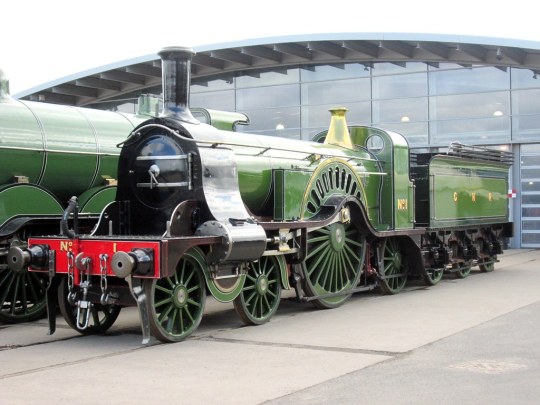


Class: Great Northern Railway (GNR) Class H1 Stirling Tank; North Western Railway (NWR) Class S-S1 Stirling Tank
Basis (Inspiration): GNR Stirling Single A3, GNR G1, and B&ER 4-2-4 tank engines
Previous Owners: Great Northern Railway; Wellsworth and Suddery Railway
Built: 1882
Real-life Withdrawal: n/a
Designer: Patrick Stirling
Builder: Doncaster Works
Bio:
Emily is an experimental tank engine version of the GNR A1, A2, and A3 Stirling Singles, with a wheel config of 4-2-4T. While she did perform decently, she did not perform as they expected so she was withdrawn. The Wellsworth and Suddery Railway took interest in Emily. They purchased her from the GNR before she could be sold to a scrapyard. She worked welled on the W&SR, able to be passed down to the NWR in 1915, along with Edward. She ended up replacing Edward on the express passenger service when the latter's rebuilds proved to worsen his performance.
NWR 4 Henry


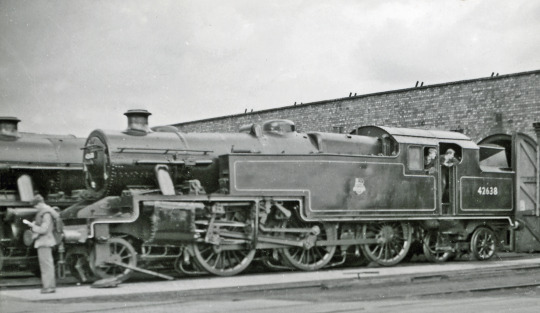

Class: North Eastern Railway (NER) Class F; North Western Railway (NWR) Class S-S5 (4-6-4T) Black Five Tank
Basis (Inspiration): NER Class D (pre-1935); LNER Class A2 (pre-1935); LMS Class 5MT Black Fives (post-1935); LMS 4MT 2-6-4T (two-cylinder) (post-1935)
Previous Owners: Unknown
Built: 1920
Real-life Withdrawal: n/a
Designer: Vincent Raven; Henry Stanier
Builder: Unknown
Bio:
Henry was built from stolen duplicates of Vincent Raven's plans of a 4-6-2T, which were derived from the NER Class D (4-4-4T). Unfortunately, these duplicate plans were the discarded designs due to uneven weights on the chassis and the use of a Schmidt boiler. He was under-powered and a hazard to operate. Sir Louis Topham Hatt I was swindled to buy Henry in 1922 when promised that Henry would be the next best thing for railways. This was when the NWR believed that they wouldn't need tender engines to run the railway. After the Flying Kipper crash, Henry was rebuilt into a new class of his own, the LMS Class 5MT Black Five Tank.
NWR 5 Gordon
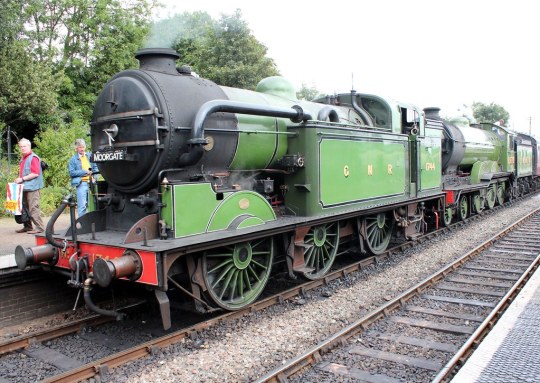
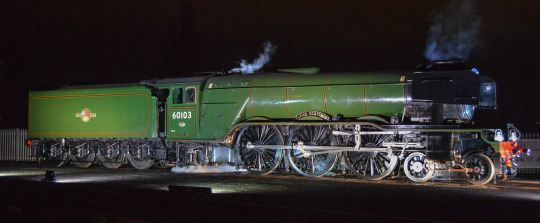
Class: Great Northern Railway (GNR) Class B1; North Western Railway (NWR) Class S-G1
Basis (Inspiration): GNR Gresley Class A1, GNR Gresley Class A3, and GNR Gresley Class N2
Previous Owners: Great Northern Railway
Built: 1920 - 1923
Real-life Withdrawal: n/a
Designer: Nigel Gresley
Builder: Doncaster Works
Bio:
Gordon is an experimental tank version of the GNR Gresley A1s, in hopes of surpassing the capabilities of the Gresley N2s. This did not work out but served as a basis for the LNER V1s. He was sold off to the NWR, replacing Emily on heavy passenger duty, which was the express service for the NWR.
NWR 6 James (formerly L&YR 506, LMS 11546)

Class: Lancashire and Yorkshire Railway (L&YR) Class 24; NWR Class S-A25
Previous Owners: L&YR, LNWR, LMS
Built: 1919
Real-life Withdrawal: 1959 (BR number would've been 51546)
Designer: John Audley Frederick Aspinall
Builder: Horwich Works
Bio:
James was bought as he was originally built in 1925. However, Sir Bertram Topham Hatt II ordered for James to be rebuilt into a 2-6-2T. This took well over a few months until they finally came up with a decent design. Unfortunately, James' great performance came at the cost of James' loosing his memories.
#ttte thomas#ttte edward#ttte emily#ttte henry#ttte gordon#ttte james#muxse meeps#''what if'' AUs are so fun#ttte#ttte au#cerenemuxse#ttte alt basis au
10 notes
·
View notes
Text

This week's locomotive of the week is LMS No.5110. 5110 was built in 1935 by the Vulcan Foundry of Newton-le-Willows, Lancashire for the LMS one of Sir William Stanier's "Black 5" class mixed-traffic 4-6-0s. She was taken in to BR stock at nationalisation in 1948 and renumbered to 45110 on the 9th of April 1949. Originally allocated to Holyhead, she bounced between sheds in the late 1960s ending up at Stafford, Bolton and finally Lostock Hall. On August 11th 1968, 45110 made history by becoming one of three Black 5s to haul the Fifteen Guinea Special, the last steam-hauled passenger service on British Railways. After the run the engine was bought by Mr. David Porter, who christened it "R.A.F. Biggin Hill", after which it was sent to it's new home at the Severn Valley Railway where it ran, having a few breif returns to the mainline before being withdrawn with some severe mechanical issues. The engine now resides at Carnforth with plans to be given a full mainline-grade overhaul in time for the 60th anniversary of the Fifteen Guinea Special in 2028.
5 notes
·
View notes
Text

Insight from Charles Laughton into his portrayal of Javert in the 1935 movie:
Javert in 'Les Miserables' is a bronze monument to the stupidity of humanity. I tried to make him a man of bronze, even to suggest the bronze in my make-up, particularly about the eyes and forehead.
Sorry there isn't more to the quote, I just wanted to add this bonus picture of Laughton in another role that was giving Javert vibes more than the movie does...

Source btw
26 notes
·
View notes
Text

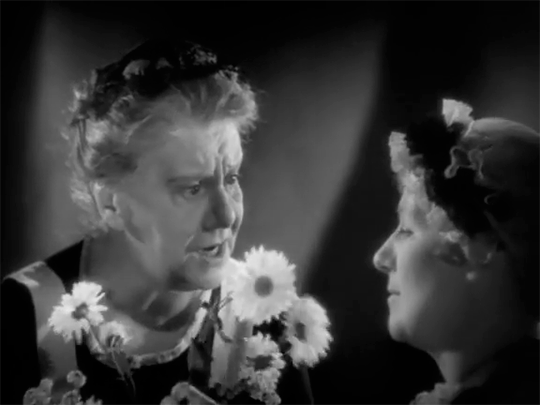



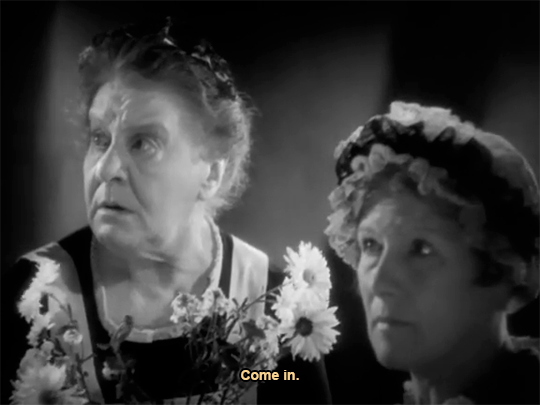
LES MIS LETTERS IN ADAPTATION - Prudence Counselled to Wisdom, LM 1.2.2 (Les Miserables 1935)
“We say that this house is not safe at all; that if Monseigneur will permit, I will go and tell Paulin Musebois, the locksmith, to come and replace the ancient locks on the doors; we have them, and it is only the work of a moment; for I say that nothing is more terrible than a door which can be opened from the outside with a latch by the first passer-by; and I say that we need bolts, Monseigneur, if only for this night; moreover, Monseigneur has the habit of always saying ‘come in’; and besides, even in the middle of the night, O mon Dieu! there is no need to ask permission.” At that moment there came a tolerably violent knock on the door. “Come in,” said the Bishop.
#Les Mis#Les Miserables#Les Mis Letters#Les Mis Letters in Adaptation#Les Mis 1935#Les Miserables 1925#Madame Magloire#Magloire#Baptistine#Baptistine Myriel#lesmisedit#lesmiserablesedit#pureanonedits#lesmiserables1935edit#lesmis1935edit#LM 1.2.2
108 notes
·
View notes
Text
The Sudrian Halls (and the tiniest bit about Duck and Casey) [NWR AU]
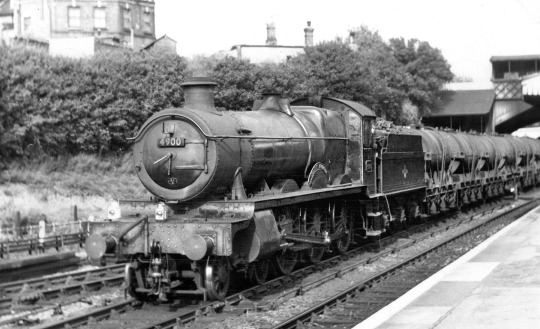
History
In 1935, the NWR entered into a locomotive loan contract with the Great Western in exchange for the sole right to supply coal to the railway for ten years. The locomotives sent to the North Western under this agreement were No. 4907 "Broughton Hall", No. 4915 "Condover Hall", No. 4911 "Bowden Hall" and No. 5948 "Siddington Hall". Also included in this deal was 5700 No. 5741, who would later become known as Duck.
The five GWR engines were stabled at Vicarstown Sheds with the LMS and ex-Furness residents, often having very loud arguments that kept the town awake. The four Halls were put to work on mixed-traffic and thunderbird duties while Duck was assigned to pilot duties, working tirelessly through the war. During 1941, Bowden Hall was recalled to the GWR to assist with the workload. Unfortunately however, he was struck by a bomb at Keyham and disposed of at Swindon Works.
After the war, the now trio of Halls were supplemented with Stanier Class 5 No. 5113, known as Casey. They continued to work diligently until 1963, when word started to spread of the Western Region recalling locomotives to Swindon Works for scrap. Not too keen on letting this happen to engines he considered part of his railway, Sir Charles Topham Hatt II purchased Condover, Siddington and Broughton, along with Casey too. The four were sent to Crovan's Gate to be repainted and lightly overhauled ready for service. While there however, the three 4900s decided they wanted to start anew. After all, they were NWR engines now. It was Condover Hall who asked Sir Topham if the trio could change their names, and he fully obliged. Condover Hall became Vicarstown Hall, Broughton Hall became Knapford Hall and Siddington Hall became Tidmouth Hall. Under these new names, the three re-entered service in 1964 and have served without fault ever since
Personalities
Vicarstown Hall is an amiable, friendly and cheeky chap who likes to have a laugh. He gets on very well with younger or sillier engines like Bill, Ben, Percy or Thomas, but is rarely allowed to interact with them due to the chaos that usually ensues. He works as hard as he plays, being a mainstay of the island's passenger and goods services.
Quite the opposite to her brother, Knapford Hall is an uptight, strict and by-the-book sort, not tolerating other engines stepping out of line even by an inch. This often puts her at odds with Vicarstown Hall, who thinks she's something of a stick-in-the-mud. Her work ethic is as strong as her anger for those who don't follow every single rule in the book, and trust me, she knows them all.
Rounding out the trio is Tidmouth Hall, one of the railway's designated thunderbird engines. Being a thunderbird engine is something he takes incredibly seriously, not having much patience for those who belittle or mock his work. Other than this, he's very friendly, caring, compassionate and trusting, though his trust and compassion can sometimes get him hurt.
All in all, the trio are a big cog in the clockwork mechanism of Sodor's railway system, doing whatever is assigned to them (for the most part) without fuss.
Thank you for reading, I'll see you in the next one.
Cheerio!
6 notes
·
View notes
Text
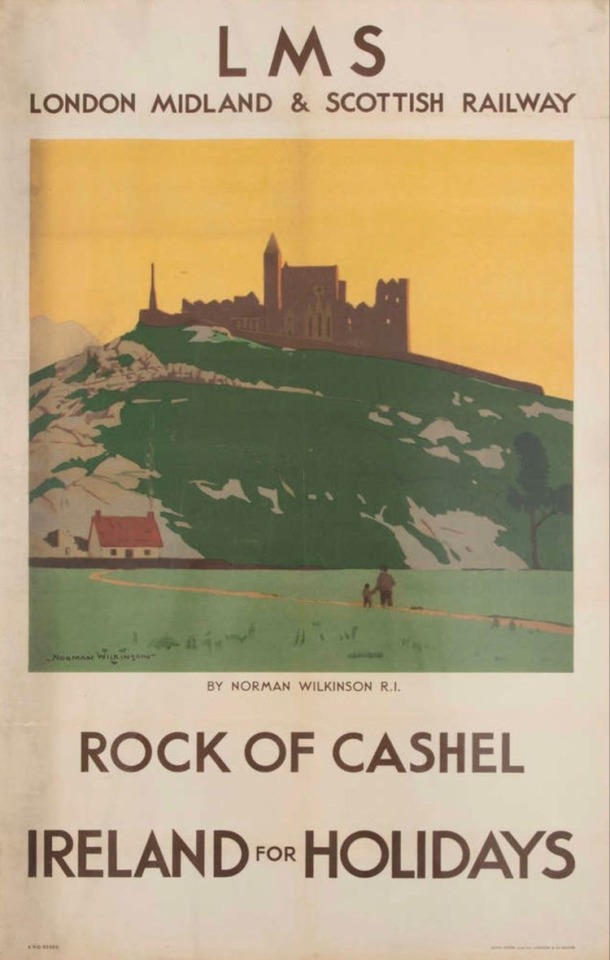
Rock of Cashel
LMS
~ Norman Wilkinson (British, 1878-1971), circa 1935
28 notes
·
View notes
Text
NWR #25 and #26: The Sodor Turbomotives.

The Sodor Turbomotives 1 and 2, AKA Orkney and Andreas respectively, are identical Pacific Steam Turbine locomotives, who work on the NWR. Orkney, who despite her name, is actually a girl, was originally the LMS Turbomotive #6202, built at Crewe Works in 1935. She was surprisingly down to earth for a express engine, especially compared to other LMS engines such as Lord Rathmore (later Big City Engine) and Princess Elizabeth, probably due to the fact that like most steam turbines, she had a really big problem with running at low speeds. This really didn't bother her too much however, and she often stood up for the little guys on the LMS. In 1946 however, one year after WW2, she was trialed on the NWR after Gordon broke down and was sent away for repairs. After doing quite well, she was purchased by the NWR later that year, and later got upgraded to be more efficient at Crovan's gate works. In 1949, her younger twin brother "Sodor Turbomotive 2", named Andreas after the last king of sodor, was built as another reserve express engine, and made so She didn't feel lonely as the only member of her class. In 2019, the two turbomotives were given the numbers 25 and 26 respectively, after sporting no numbers prior. Andreas is a Friendly yet timid and insecure engine, doubting if he could be as good as a normal steam locomotive most of the time, but he always has his older sister Orkney by his side, and the two care for and support each other a lot, "a bond as strong as iron" they would say. Since 2013, they have also been given there own express trains.
And before you ask, my AU's 6202 was purchased in 1946, before she was rebuilt into a LMS Coronation Class and destroyed in the Harrow and Wealdstone Crash of 1952 in real life.
#thomas and friends#thomas and friends au#thomas the tank engine#ttte#au#oc#ttte AU#ttte oc#LMS turbomotive#turbomotive#Orkney TTTE#Andreas ttte#Sodor Turbomotives#steam turbine#steam turbine locomotives
3 notes
·
View notes
Text
The Black Wolf
The Black Wolf was the flagship train from London to Gunnigrind. Launched in 1931 with the allocation of Royal Scot class locomotives, the about 650 mile journey taking around 16 hours, departing from their termini at 6:00 PM, and arriving at 10:00 AM the next morning.
The Black Wolf was a beast of a train, usually consisting of fourteen coaches (up until the BR days, this often included one of the LMS ex-Pullman dining cars, one rake usually had 216, the other having 219). The usual makeup had a brake coach, the dinner, two first class sleepers, two third class sleepers, three composite corridor coaches, and a third brake (later composite brake), then another first and third sleeper, a composite coach, and finally another third (later composite) brake. These final four coaches were to take up the Ben Fisag Branch.
Starting in 1933, Princess Royal class pacifics occasionally headed the train, and the Turbomotive was a common sight. In 1935 when Gunnigrind had 6204 allocated to its shed, and 6202 and 6204 largely took over The Black Wolf from the Royal Scots, although as the shed lacked a spare Pacific, they could not tighten the timetable in case of loco failures.
This changes in 1937 with the arrival of Coronation Class 6225, and so the schedule was tightened by a whole hour!
The second world war put a pause on named trains, however a similar train ran, carrying troops and people fleeing the London blitz.
In December 1947, Coronation class 6526 arrived in the island, and so the train became an almost exclusively Duchess hauled affair, although when BR 10001 arrived in July 1948, her and her LMS twin were trialled on the service, and were a regular sight doubleheading until 1949.
Also in 1949, 6202, now 46202, while climbing the bank out of Gunnigrind with the southbound Black Wolf, experienced a catastriphic turbine failure, leading to her rebuild.
On October 8, 1952, 46202, with the northbound Black Wolf, collided with an out of control stone train coming from the Ben Fisag Branch, resulting in the near destruction of both the engine hauling the goods train, 42724, and 46202, which were both written off, as well as the death of seven on the Black Wolf: both the driver and fireman, a guard, two cooks and two passengers in the dining car.
In 1954 71000 was constructed and allocated to Gunnigrind, and at first was incapable of hauling The Black Wolf satisfactorily due to design and construction flaws, which were able to be rectified at the small works in Gunnigrind that had been constructed by the LMS to repair experimental engines that were being tested on Seidrey.
In the late 1950s, Class 40s began to be allocated to The Black Wolf, and started to displace the steam locomotives from the service. However, the Class 40s had to doublehead the train to keep to time and to not overheat their engines while climbing the numerous gradients.
Because of displacement by diesel and the looming ban on near all LMS express steam traction south of Crewe due to electrification, the final steam hauled Black Wolf departed London Euston on the evening of 31 August 1964.
In 1961 the LMS sleeping cars were finally replaced by BR Mark 1s, and the train mostly stayed that way, due to utilizing composite coaches and there being no direct Mark 2 replacement.
Starting in 1966 The Black Wolf has an engine change at Crewe to an electric locomotive.
Also in 1966 the final four carriages of the consist were dropped, as the Ben Fisag Branch closed. Later the same year, Motorail service was introduced.
The Class 40s didn't last long on The Black Wolf, as they were found to be somewhat underpowered for the service. They were replaced by Class 50s in 1967, which were much more satisfactory.
In 1974, the engine change to electric traction was moved to Glasgow. Although most Class 50s has been moved to the Western Region, three had stayed behind to haul the Black Wolf
In 1977, the full brake and all the chair coaches were dropped, except for the brake composite, which was finally replaced by a mark 2 brake second open to be used solely as a lounge, leaving the train to consist merely of six coaches, not counting the Motorail flats. In 1979 the mark 1 sleepers were replaced by mark 3s.
The Black Wolf continued on in this form until its discontinuation in 1989, bringing to an end the saga of the longest distance individual train in Britain, The Black Wolf.
On June 4th, 1996, The Black Wolf name was revived, as a six to eight car segment of the Caledonian Sleeper to Gunnigrind, hauled by Class 47s until 2001, then Class 67s until 2016, when they started using Class 73/9s, which they use through the present day.
1 note
·
View note